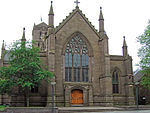Dundee ( ; Scots: Dundee; Scottish Gaelic: Dùn Dè or Dùn Dèagh, pronounced [t̪un ˈtʲeː]) is the fourth-largest city in Scotland. The mid-year population estimate for 2016 was
148,210, giving Dundee a population density of 2,478/km2 or 6,420/sq mi, the second-highest in Scotland. It lies within the eastern central Lowlands on the north bank of the Firth of Tay, which feeds into the North Sea. Under the name of Dundee City, it forms one of the 32 council areas used for local government in Scotland.
Within the boundaries of the historic county of Angus, the city developed into a burgh in the late 12th century and established itself as an important east coast trading port. Rapid expansion was brought on by the Industrial Revolution, particularly in the 19th century when Dundee was the centre of the global jute industry. This, along with its other major industries, gave Dundee its epithet as the city of "jute, jam and journalism".
Today, Dundee is promoted as "One City, Many Discoveries" in honour of Dundee's history of scientific activities and of the RRS Discovery, Robert Falcon Scott's Antarctic exploration vessel, which was built in Dundee and is now berthed at Discovery Point. Biomedical and technological industries have arrived since the 1980s, and the city now accounts for 10% of the United Kingdom's digital entertainment industry, including mobile app development and gaming. Dundee has two universities – the University of Dundee and Abertay University. In 2014, Dundee was recognised by the United Nations as the UK's first UNESCO City of Design for its diverse contributions to fields including medical research, comics and video games.A unique feature of Dundee is that its two professional football clubs, Dundee F.C. and Dundee United F.C., have stadiums all but adjacent to each other.With the decline of traditional industry, the city has adopted a plan to regenerate and reinvent itself as a cultural centre. In pursuit of this, a £1 billion master plan to regenerate and to reconnect the Waterfront to the city centre started in 2001 and is expected to be completed within a 30-year period. The V&A Dundee – the first branch of the V&A to operate outside of London – is the main centre piece of the waterfront project.In recent years, Dundee's international profile has risen. GQ magazine named Dundee the "Coolest Little City in Britain" in 2015 and The Wall Street Journal ranked Dundee at number 5 on its "Worldwide Hot Destinations" list for 2018.









